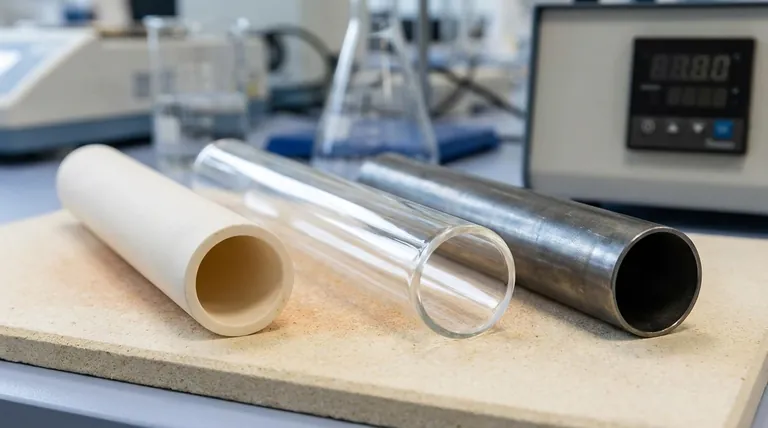In short, tube furnace tubes are most commonly made from high-purity ceramics, quartz, or specialized metal alloys. These materials are chosen for their ability to withstand extreme temperatures and resist chemical reactions. The furnace body and its insulation, by contrast, are made from different materials like stainless steel and ceramic fiber boards.
The core principle is that the tube material is not an afterthought; it is a critical component dictated by your experiment's maximum temperature, chemical environment, and required atmosphere. Choosing the correct material is essential for achieving accurate results and ensuring safety.

The Role of the Furnace Tube
The Heart of the Furnace
A tube furnace is designed around a central cylindrical chamber—the process tube. This tube is where the action happens.
It serves as the container for the material being heated (the sample) and maintains the controlled atmosphere required for the process, whether that's air, an inert gas, or a vacuum.
Separating Sample from Elements
The tube's primary function is to isolate the sample from the furnace's heating elements. This prevents contamination and allows for precise atmospheric control that would be impossible otherwise.
Common Tube Materials and Their Properties
Ceramic Tubes (Alumina)
High-purity alumina (Al2O3) is one of the most common materials for furnace tubes. It is a refractory ceramic known for its excellent performance at very high temperatures.
These tubes offer great thermal insulation and chemical stability, making them suitable for a wide range of high-temperature applications.
Quartz Tubes
Quartz is another popular choice, particularly for processes that require high chemical purity and thermal shock resistance at moderate temperatures (typically below 1200°C).
Its transparency also allows for visual observation of the sample during the heating process, which can be a significant advantage in certain research scenarios.
Metal Alloy Tubes
For specific applications like vacuum sintering, tubes are often made from imported, heat-resistant metal alloys.
These alloys are selected for their durability and ability to maintain structural integrity under high vacuum and high-temperature conditions without releasing volatiles that could contaminate the sample. They are often used with non-metallic inner liners to further ensure purity.
Factors That Determine Material Choice
Maximum Operating Temperature
The single most important factor is the required temperature. Quartz tubes are generally limited to around 1200°C, while certain high-purity alumina tubes can operate well above 1700°C.
Chemical Compatibility
The tube material must be chemically inert with respect to the sample and any process gasses used. An incompatible material can react with the sample, introducing impurities and invalidating the experiment.
Process Atmosphere
The intended atmosphere—air, inert gas (like argon), or high vacuum—heavily influences the material choice. For example, heat-resistant metal alloys are specifically engineered to perform in high-vacuum environments where ceramics might be less suitable.
Understanding the Trade-offs
Ceramics: Brittleness and Thermal Shock
The primary drawback of ceramic tubes like alumina is their brittleness. They are susceptible to cracking if heated or cooled too quickly (thermal shock) and must be handled with care to avoid mechanical stress.
Quartz: Temperature and Chemical Limitations
While excellent for many applications, quartz has a lower maximum operating temperature than alumina. It can also devitrify and become brittle if held at high temperatures for extended periods and may react with certain alkaline or basic compounds.
Metal Alloys: Cost and Potential Reactivity
Specialized metal alloy tubes are often more expensive than their ceramic or quartz counterparts. While designed for stability, some alloys can still react or off-gas at the highest end of their temperature range, which is why they are sometimes paired with protective inner liners.
Selecting the Right Tube for Your Application
Choosing the correct tube is a critical decision based on your specific experimental goals.
- If your primary focus is extreme temperature resistance (above 1200°C): A high-purity alumina ceramic tube is almost always the correct choice.
- If your primary focus is working under a high vacuum: A specialized heat-resistant metal alloy tube is specifically designed for this purpose.
- If your primary focus is high purity at moderate temperatures or visual monitoring: A quartz tube offers superior chemical inertness and clarity for these applications.
Ultimately, matching the tube material to the precise demands of your process is fundamental to successful and repeatable thermal processing.
Summary Table:
| Material | Max Temperature | Key Features | Best For |
|---|---|---|---|
| Alumina Ceramic | > 1700°C | High temp resistance, chemical stability | Extreme heat applications |
| Quartz | < 1200°C | High purity, thermal shock resistance, transparent | Visual monitoring, moderate temps |
| Metal Alloy | Varies by alloy | Vacuum compatibility, structural integrity | High-vacuum sintering |
Need help selecting the perfect tube furnace tube for your lab's specific requirements? KINTEK specializes in lab equipment and consumables, serving laboratory needs with expert guidance on high-temperature materials. Our team can help you match the ideal tube material—whether ceramic, quartz, or metal alloy—to your temperature, atmosphere, and purity goals. Contact us today to ensure your thermal processes are accurate, safe, and repeatable!
Visual Guide

Related Products
- 1700℃ Laboratory Quartz Tube Furnace with Alumina Tube Tubular Furnace
- 1400℃ Laboratory Quartz Tube Furnace with Alumina Tube Tubular Furnace
- 1200℃ Split Tube Furnace with Quartz Tube Laboratory Tubular Furnace
- High Pressure Laboratory Vacuum Tube Furnace Quartz Tubular Furnace
- Laboratory Quartz Tube Furnace Tubular RTP Heating Furnace
People Also Ask
- What tube is used for tubular furnace? Choose the Right Material for Temperature & Atmosphere
- What are the tubes in a furnace called? Understanding the Role of the Working Tube
- What is the ceramic tube high temperature? From 1100°C to 1800°C, Choose the Right Material
- What is the pressure on a tube furnace? Essential Safety Limits for Your Lab
- What precautions should be taken when using a tube furnace? Ensure Safe, Effective High-Temperature Processing



















